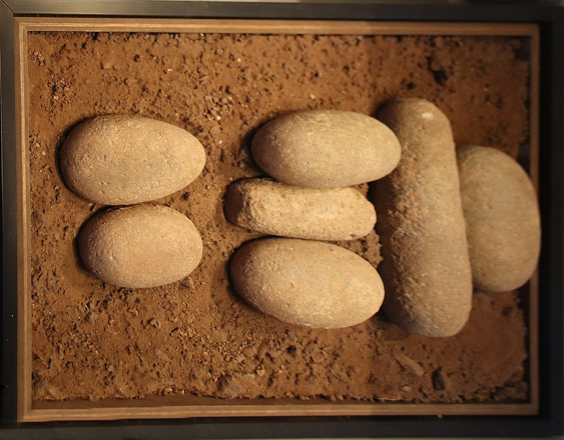You are here
Boyd explores prehistoric research, Natufian mortuary practices in Levant
By Saeb Rawashdeh - Apr 03,2025 - Last updated at Apr 03,2025

Schematic human figure made of pebbles, from Ain Mallaha, dated to 12,000 BC (Photo courtesy of Gary Todd)
AMMAN — The prehistoric research of contemporary Palestine is neglected and Professor Brian Boyd from Columbia University deals with prehistory during the Mandate and more modern periods.
Boyd received his PhD degree in archaeology at the University of Cambridge. Following that, he was a research fellow at Cambridge until 1997, after which he became a lecturer in archaeology at the University of Wales Lampeter between 1997 and 2006.
Archaeology and history play an important role in creating different political narratives and influencing public perception and higher education. Therefore, research and teaching on prehistory of Palestinian universities currently finds itself in a much-reduced state compared to institutions across the Green Line.
"Active field projects on prehistoric sites are very rare in contrast to a plethora of Israeli- run projects," Boyd said.
Regarding the Epipalaeolithic Natufian Period mortuary practice in the Levant, Boyd said that scholars know a great deal about how people treated the dead from their communities.
"There are approximately 100 Natufian sites that have been excavated all across Southwest Asia [in Palestine, Jordan, Lebanon, Syria], but only some of these sites (around 20-25) contain human burials, which suggests to us that certain places in the landscape were deliberately chosen as appropriate places to bury the dead," Boyd said.
The archaeologist added that quite often, these people were buried with animals, or parts of animals (fox, gazelle, tortoise, dog), accompanied by food processing equipment, such as pestles and mortars, and occasionally were buried wearing clothing and body decoration (shells from the Mediterranean or local water sources), and sometimes wrapped in "shrouds" or contained in "coffins", the remains of which are often only discernible through detailed analysis of the bodies and their surrounding soils.
As a student, Boyd worked at Hayonim Terrace and at 'Ain Mallaha, which is in the Upper Jordan Valley, close to the border with Lebanon.
"At both of these sites we found Natufian architecture [circular stone structures, some of which were probably dwellings], many human burials, sometimes accompanied by animals," Boyd underlined.
The professor added that "remains, such as gazelles, dogs, tortoises, and the remains of ancient plants and wild cereals [wheat, barley], and many thousands of stone and bone objects, most of which relate to food practices [gathering, hunting, cultivating], but also some that are often referred to as 'art' objects [but we have to be careful about using such modern terms when discussing material from deep history]."
Regarding Boyds' plans, he said: "I prefer to use the term 'representation'. Along with colleagues and students from Birzeit University and the UK, I am currently working in the landscapes of the village of Shuqba, in the Occupied West Bank, close to Ramallah. Our work is in progress, but we are focusing on landscape use by Epipalaeolithic [Natufian] and Middle Palaeolithic [Neanderthal] communities."











